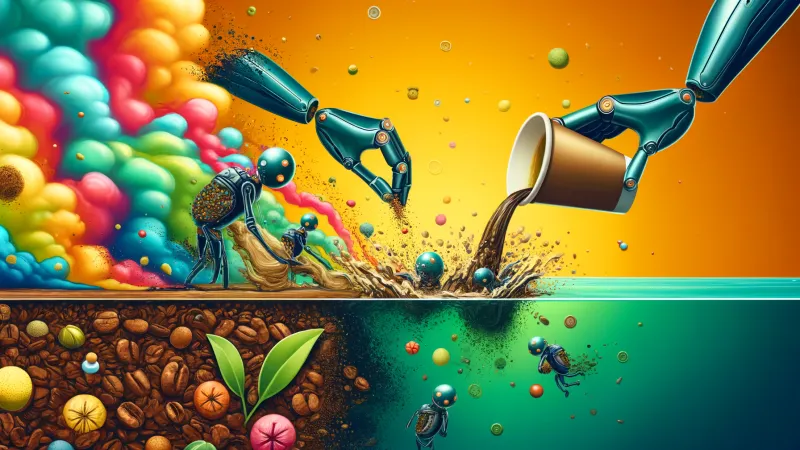How to Turn Used Coffee Grounds into Water-Cleaning Superbots
How George Mason University's Nanotechnology Research Is Turning Waste From Your Daily Brew into a Powerful Pollution Solution

DALL-E / Coffee Grounds Cleaning Water
This article was discussed in our Next Byte podcast.
The full article will continue below.
Background
Global water pollution presents a formidable challenge, with traditional remediation methods often falling short due to their inefficacy, high costs, and environmental burden. This context underscores the urgent need for innovative solutions that are both effective and sustainable.
The Team and Their Inspiration
"CoffeeBots" are a collaborative invention by Jeff Moran, an Assistant Professor of Mechanical Engineering at George Mason University, Amit Kumar Singh, a postdoctoral researcher at GMU, and Tarini Basireddy, an undergraduate student at Johns Hopkins University. Together, they engineered a low-cost and environmentally friendly solution to address severe water contamination issues using everyday materials.
Technical Details of CoffeeBots
Composition and Manufacturing: CoffeeBots consist of spent coffee grounds coated with iron oxide nanoparticles. The synthesis of these nanoparticles employs green chemistry principles, ensuring an eco-friendly production process. The nanoparticles adhere to the coffee grounds, leveraging the grounds’ natural porous and hydrophobic surface, which is ideal for adsorbing oil and microplastics.
Functionalization: Further enhancing their pollutant-binding capabilities, CoffeeBots are functionalized with ascorbic acid. This addition targets the removal of methylene blue dye, a common pollutant in industrial wastewater. The ascorbic acid acts both as a bioadsorbent and a reducing agent, facilitating the breakdown of the dye into less harmful compounds.
Magnetic Navigation and Recovery: The integration of iron oxide nanoparticles allows for the magnetic manipulation of CoffeeBots. This feature enables the remote guidance of CoffeeBots through contaminated waters and their subsequent retrieval via magnetic forces once the cleanup task is completed. This magnetic property not only simplifies the operation but also allows for the reuse of CoffeeBots, significantly reducing the cost and environmental impact of the cleanup process.
Performance and Efficiency: In practical applications, CoffeeBots demonstrate a high efficacy in capturing and removing oil, microplastics, and dye pollutants from seawater. Their movement, driven by external magnetic fields, increases their contact with pollutants, enhancing the efficiency of pollutant uptake compared to static methods. Laboratory tests confirm that CoffeeBots can be recycled multiple times without significant loss of functionality, showcasing their durability and long-term usability.
Significance of the Solution
CoffeeBots exemplify a breakthrough in water purification technology by combining low-cost materials, innovative nano-engineering, and environmental sustainability. This technology not only addresses the immediate need for effective water purification but also aligns with global sustainability goals by repurposing waste products and minimizing chemical inputs.
Future Prospects and Applications
Ongoing research aims to extend the capabilities of CoffeeBots, including the exploration of solar-activated propulsion mechanisms that would eliminate the need for external magnetic controls, thereby enhancing the autonomy of the CoffeeBots for more extensive and less supervised water treatment operations.
Conclusion
The creation of CoffeeBots by the team at George Mason University marks a meaningful advancement in nano- and environmental engineering. By harnessing simple yet innovative materials and methods, they have developed a promising solution to combat the pervasive issue of water pollution. As this technology evolves, it holds the potential to revolutionize water purification practices globally, offering a potential beacon of hope for millions affected by polluted water sources.
